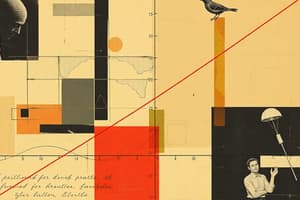Podcast
Questions and Answers
Why do indifference curves typically slope downward?
Why do indifference curves typically slope downward?
- To indicate scarcity of goods
- To demonstrate consumer preferences
- To show the trade-off consumers face when choosing between goods (correct)
- To highlight the price differences between goods
What do indifference curves represent?
What do indifference curves represent?
- Combinations of goods that yield equal satisfaction (correct)
- Combinations of goods with varying quality levels
- Combinations of goods with different prices
- Combinations of goods that result in maximum utility
What does convexity of indifference curves indicate?
What does convexity of indifference curves indicate?
- Consumers face diminishing marginal utility
- Consumers prefer extreme consumption of a single good
- Consumers prioritize price over quantity
- Consumers prefer a balanced combination of goods (correct)
Which property should indifference curves not exhibit?
Which property should indifference curves not exhibit?
What is the significance of the increasing utility property of indifference curves?
What is the significance of the increasing utility property of indifference curves?
How do consumers behave when choosing a point on an indifference curve?
How do consumers behave when choosing a point on an indifference curve?
What is the main purpose of constructing an indifference curve in economics?
What is the main purpose of constructing an indifference curve in economics?
How do consumers make choices between goods using indifference curves?
How do consumers make choices between goods using indifference curves?
What does the intersection of an indifference curve and a budget line represent for a consumer?
What does the intersection of an indifference curve and a budget line represent for a consumer?
How is consumer surplus calculated using indifference curves?
How is consumer surplus calculated using indifference curves?
What assumption does indifference curve analysis make about consumer behavior?
What assumption does indifference curve analysis make about consumer behavior?
In what way can indifference curves help economists understand consumer behavior?
In what way can indifference curves help economists understand consumer behavior?
Flashcards are hidden until you start studying
Study Notes
Understanding Consumer Behavior through Indifference Curve Analysis
Indifference curve analysis is a crucial tool in economics that helps us dissect the complexity of consumer behavior. As you delve into the world of indifference curves, you'll discover how consumers make choices that balance trade-offs between goods, maximize their utility, and follow consistent patterns.
What Are Indifference Curves?
Indifference curves represent all the combinations of two goods that yield equal satisfaction or utility for a consumer. Consumers will always prefer a point on their indifference curve that provides more of one good and less of another, to a point that provides less of the preferred good and more of the undesired good.
The Shape of Indifference Curves
Indifference curves typically slope downward, revealing that as consumers have more of one good, they can consume less of another good, while holding utility constant. This downward slope illustrates the trade-off consumers face when choosing between goods.
The Properties of Indifference Curves
- Convexity: Indifference curves are usually convex to the origin, indicating that consumers prefer a balanced combination of goods to an extreme consumption of a single good.
- Monotonicity: Indifference curves should not have any loops or crossings.
- Increasing Utility: Indifference curves should be higher for higher levels of utility.
Producing and Interpreting Indifference Curves
To construct an indifference curve, economists use a consumer's preferences over different combinations of goods. For example, let's consider a consumer who prefers more apples to oranges but also prefers a combination of the two goods instead of either one alone. The economist would collect the consumer's responses to different hypothetical scenarios and plot the points of equal utility.
Indifference Curves and Consumer Choice
Indifference curves help us understand how consumers make choices between goods. When consumers face different prices and incomes, their budget lines will shift. They will choose the point at which their budget line and an indifference curve intersect due to the law of demand, which states that consumers will buy more of a good when its price decreases and their income remains constant.
The Relationship Between Indifference Curves and the Consumer's Budget Constraint
The intersection of an indifference curve and a budget line presents the consumer's optimal bundle of goods. When a consumer's budget line shifts, their optimal bundle of goods will also change, reflecting the trade-off they must make between goods.
Indifference Curves and Consumer Surplus
Indifference curves can also be used to calculate the consumer surplus, which is the difference between the maximum amount a consumer is willing to pay for a good and the actual price they pay. It measures the benefit a consumer receives from consuming a good or service.
Limitations of Indifference Curve Analysis
Indifference curve analysis does not cover all aspects of consumer behavior. It assumes that consumers have stable preferences and make rational decisions. In reality, consumers may not always act rationally, and their preferences may change over time.
Conclusion
Indifference curve analysis is a valuable tool in understanding consumer behavior. By analyzing indifference curves, economists can examine consumer choice, price and income elasticities, and the relationship between consumer surplus and market demand. While indifference curve analysis has its limitations, it helps economists understand consumer behavior in a more complex world, where choices between goods are made based on trade-offs and preferences.
Studying That Suits You
Use AI to generate personalized quizzes and flashcards to suit your learning preferences.




